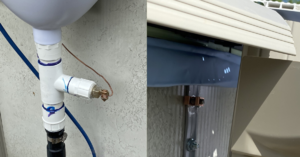Technical Details of Bonding a Pool
This wiki is a supplement to the Bonding vs Grounding article in TFP Pool School.
Pool electrical code requirements are described in the National Electric Code (NEC) section 680. The NFPA provides free access to the NEC and other codes.
Taking the Mystery Out of Equipotential Bonding Requirements for Swimming Pools is a good primer to understand equipotential bonding in pools.
A good reference is from Mike Holt Enterprises on Article 680—Swimming Pools, Spas, Hot Tubs, Fountains, and Similar Installations.
Also How to Verify That a Pool is Safe from Electric Shock – In Accordance with the National Electrical Code from Mike Holt.
Questions often come up asking if an Above Ground Pool needs to be bonded. The NEC does not refer to Above Ground Pools. The NEC says permanently installed swimming, wading, immersion, and therapeutic pools constructed in the ground or partially in the ground, and all others capable of holding water in a depth greater than 42 in., and pools installed inside of a building, regardless of water depth, whether or not served by electrical circuits of any nature must be bonded.
Bonding requirements for above ground pools include:
- The bonding conductor must be 8 AWG bare solid copper[1]
- You can not use sheet metal screws or rivits to connect the bonding conductor.
- The bonding conductor must be secured in or under the deck or unpaved surface within 4 in. to 6 in. below the subgrade and must be located between 18 in. and 24 in. from the inside walls of the pool.
- All fixed metal parts within 5 feet of the pool must be bonded to the equipotential grid, including but not limited to, "metal-sheathed cables and raceways, metal piping, metal awnings, metal fences, and metal door and window frames."
- Attachments for the bonding wire must be listed for the application.
- The pool water must be bonded to the bonding loop with a device like:
- the Burndy BWB680AGRK Waterbug Pool Water Bonding Kit.[2] You drill a hole through your skimmer and install it there.
- the Perma-Cast PB2008 Water Bonding Fitting PB-2008 in the pipe going to the pump on a tee fitting
- From the loop you will also need to provide a connection that will go to the pump bonding lug, heater bonding lug and any other metal component at the pad.
- Copper lugs and split bolts are used to connect the bonding wires together into one loop.
- at a minimum four (4) points uniformly spaced around the perimeter of the pool connected to the bonding loop is required. On an above ground pool this may require drilling 4 holes equally spaced at 4 points around the pool low enough that they will be below the liner and attach the direct burial rated lugs that way.[3]
- on a pool with a metal wall code requires one bond point. This post explains the logic.
The NEC does make note that not all pool shells/frames can be bonded because they are either plastic or fiberglass. Then make sure your pump and water are bonded and heater if you have one.
Troubleshooting a Tingle or Shock
Finding stray voltage sources take a lot of detective work. Here are two threads to give you ideas of what you are looking for:
Here is a thread that has been going on for 6 years trying to find the source of a tingle - A Slight Shock.
Here the voltage source was a streetlight connected to the house power line Bonding Issue In A Pool.
- ↑ https://www.troublefreepool.com/threads/bonding-above-ground-pool-trying-to-understand.109181/post-959987
- ↑ https://www.troublefreepool.com/threads/18x34-doughboy-autumn-breeze-finished.44544/post-383567
- ↑ https://www.troublefreepool.com/threads/bonding-issues-for-above-ground-pool.119829/post-1060396




